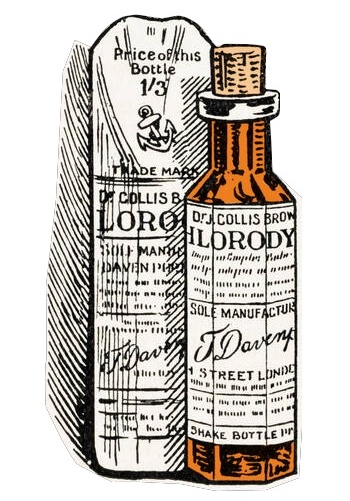 A popular wonder drug of the 19th century, this patent medicine packed multiple punches.
A popular wonder drug of the 19th century, this patent medicine packed multiple punches.
In 1848, Dr John Collis Browne had a problem. After training as a doctor in London and building his professional expertise, he had joined the Army Medical Service as an assistant surgeon.
The career shift found him in India during a cholera outbreak.1-3 What to do? The innovative 29-year-old formulated a remedy made from chloroform, morphine, cannabis and laudanum. He named it Chlorodyne, and it worked a treat.1-3 When Collis Browne left the army, he sold the formula to London pharmacist John Thistlewood Davenport to manufacture and advertise. And promote it Davenport did. Advertisements appeared everywhere: magazines, newspapers, railway stations and more.3
‘The original and only genuine Chlorodyne’ was billed as a wonder drug, able to treat conditions ranging from cough, consumption and diphtheria, to diarrhoea, neuralgia, epilepsy, cancer and, of course, cholera.14
Thanks to its powerful ingredients, Chlorodyne really did relieve pain, cause sleepiness and euphoria, and improve diarrhoea.3 Also known as Dr Collis Browne’s Chlorodyne and similar variations, Chlorodyne became one of the most famous patent medicines sold in Britain.3
How it works
Morphine and laudanum are opioids. They activate receptors in the brain, spinal cord and peripheral nervous system. There are three major classes of opioid receptors:δ-opioid, κ-opioid and μ-opioid. When activated, they reduce neuronal excitability, inhibiting the release of pain transmitters. Other actions reduce anxiety and increase relaxation, sleepiness and euphoria. The μ-opioid receptor is critical to addiction due to its link to dopamine release.7,8
Like its opioid cousins, cannabis activates receptors – in this case CB1 and CB2 – which are predominantly inhibitory. CB1 is mainly located in the central and peripheral nervous systems, altering neurotransmitter release, and CB2 on immune cells, modifying cytokine release.9 Chloroform causes unconsciousness, blocking the calcium ion channel TRPC5, found predominantly in the brain. It plays a role in signalling the central nervous system to regulate consciousness.10
Colonial reach
According to Melbourne academic and self-confessed ex-heroin addict James Rowe, Chlorodyne was a hit in 19th century Australia, where drug-taking was a ‘national trait’.4-6
Although Chlorodyne sales contributed to a rise in accidental overdose and addiction, the ‘therapeutic’ use of opiates was largely unregulated at the time. Manufacturers didn’t even need to list ingredients.4
‘Purchasers of Dr Collis Browne’s Chlorodyne, for example, would have been unaware of the six grains of morphine and six grains of cannabis extract contained within,’ notes Rowe.4
Chlorodyne now
Today, Chlorodyne HQ remains in the United Kingdom. Manufactured legally by Thornton and Ross Ltd as J. Collis Browne’s Mixture, it is marketed as a remedy for coughs and diarrhoea symptoms.11
Ingredients include morphine hydrochloride, peppermint oil, ethanol, benzoic acid, capsicum tincture, caramel, menthol, citric acid, hypromellose, sorbitol solution, treacle and purified water.11,12
But don’t look for it in Australian pharmacies. Chlorodyne is not included on the Australian Register of Therapeutic Goods and is not available for supply or use here.13 And forget online sales.
Chlorodyne contains morphine hydrochloride, a Schedule 8 poison, so an import permit is required. The steps required: mind-altering.13
References
-
- The Oldie. Oldie Life: What was Chlorodyne.
- Yakushigaku Zasshi. Memoirs on Chlorodyne and Shinyaku. 1999;34(2):89–96.
- Definitions. Chlorodyne.
- Rowe J. Pure Politics: A historical look at Australian drug policy. AltLawJI 2001;26(3)125.
- Rowe J. Australia’s love affair with drugs. The Conversation. 2012.
- Rowe J. Heroin made life bearable – at the same time as it nearly killed me. Sydney Morning Herald. 2017.
- Chahl LA. Opioids – mechanisms of action. Aust Prescr 1996;19:63–5
- DrugBank. Opium. 2022.
- Murnion B. Medicinal cannabis. Aust Prescr 2015;38:212–15.
- University of Leeds. Chloroform Provides Clue To 150 Year Old Medical Puzzle. ScienceDaily. ScienceDaily. 2008.
- Datapharm. J. Collis Browne’s Mixture. 2010.
- Electronic Medicines Compendium. J Collis Browne’s Mixture. 2020.
- Australian Government Department of Health. Therapeutic Goods Administration. Reply to inquiry from Leigh Dayton 7 July 2022.
- Phillips J. Drugs – Colonial drug-taking. Te Ara – the Encyclopedia of New Zealand, 5 Sep 2013.






 ‘We’re increasingly seeing incidents where alert fatigue has been identified as a contributing factor. It’s not that there wasn’t an alert in place, but that it was lost among the other alerts the clinician saw,’ Prof Baysari says.
‘We’re increasingly seeing incidents where alert fatigue has been identified as a contributing factor. It’s not that there wasn’t an alert in place, but that it was lost among the other alerts the clinician saw,’ Prof Baysari says.







